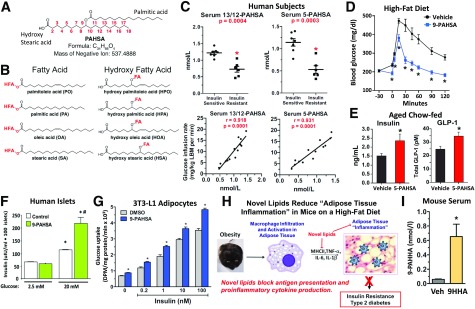Figure 7.
FAHFAs are a novel class of lipids with beneficial metabolic and anti-inflammatory effects. A: FAHFAs consist of a fatty acid group, such as palmitic acid, and a hydroxy fatty acid group joined by an ester bond (PAHSA). B: FAHFAs can consist of multiple different fatty acids and their hydroxy fatty acids in various combinations. Examples of some constituent fatty acids are shown. C: PAHSA levels in serum are lower in insulin-resistant people than in the insulin-sensitive people and serum levels correlate highly with insulin sensitivity determined by glucose infusion rate during a euglycemic-hyperinsulinemic clamp. A single oral dose of PAHSA improves glucose tolerance of high-fat diet–fed mice (D) and augments insulin and GLP1 secretion in aged, insulin-resistant chow-fed mice (E). These secretory effects are not seen in high-fat diet–fed mice. PAHSAs enhance glucose-stimulated insulin secretion directly in human islets (F) and enhance insulin-stimulated glucose transport in cultured adipocytes (G). H: Anti-inflammatory effects of PAHSAs include blocking antigen presentation, proinflammatory cytokine production, and costimulatory molecule production. This leads to decreased adipose tissue inflammation and insulin resistance. I: Administration of 9HHA, a nonnatural hydroxy fatty acid, results in the synthesis of 9PAHHA, proving that PAHSA can be synthesized in vivo. For experimental details for panels A–G and I, see Yore et al. (30). Panels A–G and I reprinted from Yore et al. (30). *Panel C: P < 0.0005 vs. insulin-sensitive subjects; panels D, E, and I: P < 0.05 vs. vehicle (Veh); panel F: P < 0.05 vs. 2.5 mmol/L glucose, same treatment; panel G: P < 0.05 vs. DMSO, same insulin concentration. #P < 0.05 vs. control, same glucose concentration. DPM, disintegrations per minute; LBM, lean body mass.

